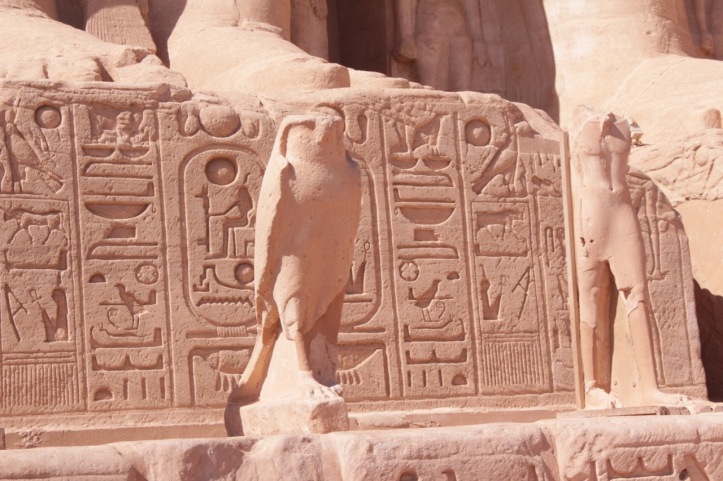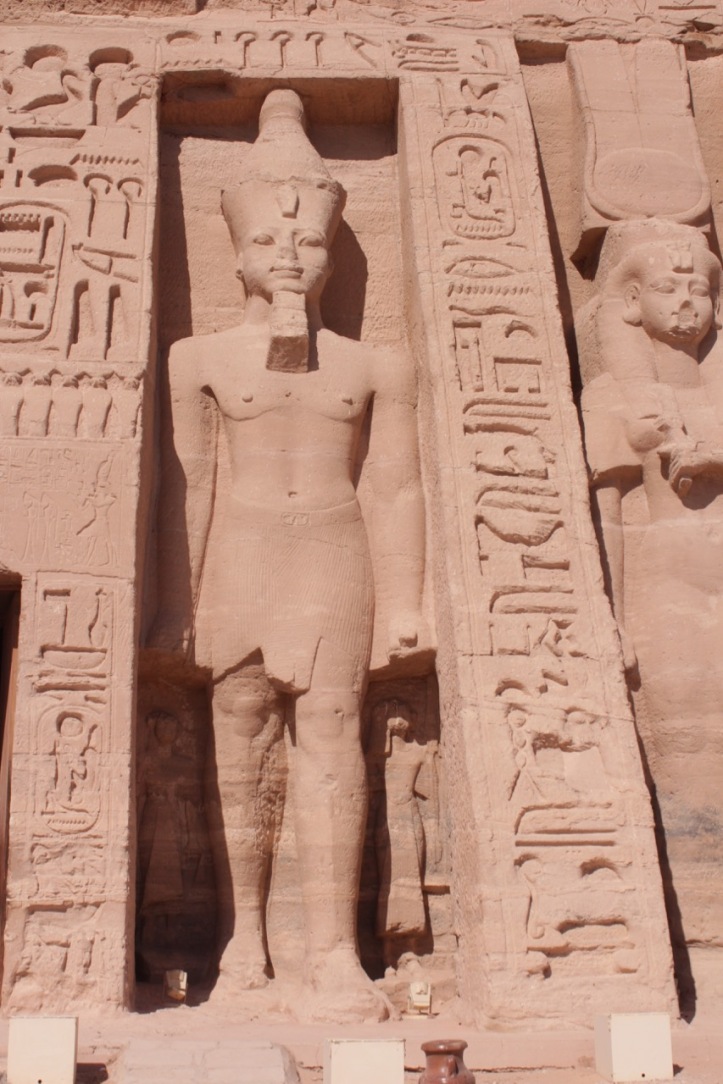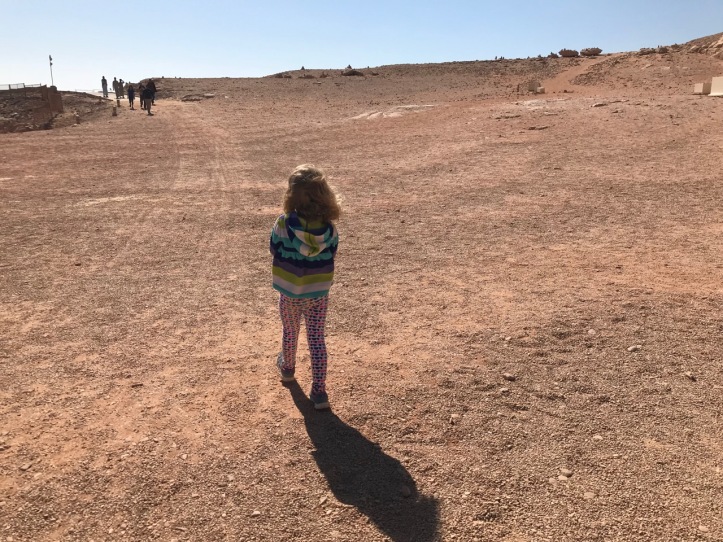 Abu Simbel is one of those places that if you live in Egypt, is on your bucket list, and if you don’t, you’ve probably never heard of it. The largest temple in Nubia, it was built by the Pharaoh Ramesses II as a temple to the gods Amun-Re, Re-Harakthi, and Ptah in about 1265 BC. It also deified Ramesses himself and definitely shows his large ego! It was carved out of stone directly in a mountain and is a remarkable display of craftsmanship. They were discovered in 1813 by Swiss Orientalist and traveler Ludwig Burckhardt. However, they were covered with sand and he could not enter them. Four years later, Paduan explorer Giovanni Battista Belzoni was able to enter them for the first time.
Abu Simbel is one of those places that if you live in Egypt, is on your bucket list, and if you don’t, you’ve probably never heard of it. The largest temple in Nubia, it was built by the Pharaoh Ramesses II as a temple to the gods Amun-Re, Re-Harakthi, and Ptah in about 1265 BC. It also deified Ramesses himself and definitely shows his large ego! It was carved out of stone directly in a mountain and is a remarkable display of craftsmanship. They were discovered in 1813 by Swiss Orientalist and traveler Ludwig Burckhardt. However, they were covered with sand and he could not enter them. Four years later, Paduan explorer Giovanni Battista Belzoni was able to enter them for the first time.
Abu Simbel, the town, is in the middle of no where and is the southernmost town before Sudan. It has an airport and EgyptAir does flights from Aswan daily. However, most people elect to visit Abu Simbel either by a Lake Nasser cruise or by car from Aswan, which is what we did. The drive has to be done during daylight hours as almost all of the 3 hour drive is in deserted desert! You would not want to break down or have an emergency there. Miles and miles of sand and small hills. The drive used to be unsafe to do except in a military convoy that departed Aswan each day as the sun rose to make the drive to Abu Simbel and back. Luckily now you can go on your own timing as long as it’s daylight.
If you’re doing Abu Simbel in connection with visiting Aswan, make sure to read my post about Aswan, here.

The temple of Ramesses is fascinating. The facade has 4 giant statues of Ramesses II himself with a row of 22 baboons (sun worshippers) along the top. Smaller statues of his favorite wives and children nestle between his legs. Inside is a giant carved cavern with multiple side chambers carved with pictures and hieroglyphs and a huge center hall called the Hypostyle hall with 8 pillars carved like Ramesses II (made to look like the god Osiris). At the very back is a worship sanctuary with 4 statues–the gods Ptah, Amun-Re, Re-Harkhti and Ramesses himself. While Pharaohs were considered god-like none except Ramesses claimed god status while alive (the belief being they would be gods upon death). His portrayal of himself as a god with 3 other gods is highly unusual. Photography was not allowed inside, but you can find some if you google it.

One cool thing about the temple is that twice a year, mid October and mid February, the sun rays enter the temple and illuminate 3 of the 4 statues in the very back. Ptah, the god of the underworld and darkness, remains in the dark. There are large events at the temple twice a year when this happens.
On the same complex is the Temple of Hathor and Nefertari. It is dedicated to the goddess Hathor and Ramesses favorite wife, Nefertari. It is the first time in Egypt’s history that a temple was dedicated to a queen. The front has 6 statues–4 are of Ramesses (even in a temple for his wife, he still had to be most prominent) and 2 are Nefertari. Significantly, the 2 of Nefertari are almost the same size as the ones of Ramesses. Normally the wives were significantly smaller than the rulers. It shows how much fondness Ramesses has for Nefertari and their close bond. The inside is similar, though smaller, than that of Ramesses’ Temple. It was built first, perhaps as a test run for the larger temple.

One of the most fascinating details of the Abu Simbel temples is that they are not in their original location. After the construction of the High Dam in Aswan, the Nile started flooding to create Lake Nasser. As the waters rose and spread, there was a race against time to move and save various Nubian statues, monuments and temples. UNESCO and different countries around the world stepped in to plan and fund these efforts. Abu Simbel’s dismantling and reconstruction lasted from 1964-1968 and was the most complex. They cut massive blocks of stone, moved them 65m up and 180m back from their original location, and reassembled them to face the same direction (almost, it was adjusted slightly so the sun would have the same effect at the higher elevation). Some of these blocks weighed more than 10 tons! This 3 min National Geographic video shows inside footage and information about why the move was needed. This video shows the moving itself.

How Our Day Went:
We left the hotel in Aswan at 7:30 by private van and driver. We arranged that through SEEgypt, whom we have used several times. The drive is long and straight-about 3 hours through the desert. There is a stopping spot about halfway though where you can use the bathroom if need be. We didn’t stop though. At the temples we used the bathroom, picked up our guide, and got tickets. Then we walked around to the front side. The views of Lake Nasser are great. It was windy and beautiful.

Our guide gave us the history of the two temples, including showing us pictures of details inside to look for. Then we explored them on our own. The suggestion is to start at the smaller temple to Nefertari and then move to the larger temple so you are impressed by both. There were a lot of people, but the complex is large enough it didn’t feel crowded.
DS was super cranky as he had been sick the night before and hadn’t had much sleep and so I wore him the whole time and he fussed. DD mostly wanted to collect rocks (not old rocks! Just the rocks used for paths and things). Here we were visiting an old and amazing temple and she’s picking up gravel and stacking it and trying to convince me to keep it!


Inside the temples were very impressive! The amount of detail and coverage is amazing. Not to mention the size of the statues. Very much worth seeing.
Exiting you have to walk past a long line of vendors hawking their wares, sometimes obnoxiously! We did buy a magnet, which DH used made Arabic bargaining skills to get the price lowered. DS cracked me up by yelling “La! La!” and shaking his head at the vendors trying to show me things. He doesn’t know much Arabic, but he knows “no!” The vendors cracked up also and backed off.

There is a small food stand at the parking lot where you can get snacks and drinks. Kids enjoyed ice cream bars while sitting at a table in the shade.
Then we headed over to a Nubian guesthouse for lunch. Our guide called ahead so it was ready when we arrived to save time. The kids shared our food as they didn’t have much of an appetite. The food was AMAZING. So good! We had chicken from a tagine and various sides. The bread was yummy and their had good beverage options too. Plus bathrooms and a large patio for kids to run around on. Some people elect to overnight at Abu Simbel so they can see the temple as the sun rises with fewer crowds.
Ended our day with the drive home and reached the hotel by about 4:30.


Trip Practicalities:
How to Reach: You can fly from Aswan to Abu Simbel via an EgyptAir flight. This gives you 3 hours on the ground (which includes time to/from). It’s a fast turn around. You can also do a Lake Nasser cruise which takes several days (4 I believe) and departs from Aswan, stopping at various temples only reachable by boat. Or you can arrange a private car and driver, which we did. All tour companies and hotels can arrange. We used SEEgypt.
Timing: If driving, you need to be driving during daylight. In the winter this meant leaving no later than 8 am so you can return by 5 pm. The drive is about 3 hours from Aswan. It’s about 2 hours touring the temples and then time for lunch if desired. Or bring a picnic.
Cost: Our van, driver and guide was 2145le ($120 or so). Entrance fee was 160le ($9) per adult (our kids were young enough to be free). I don’t remember the lunch cost, but it was very reasonable.
Lunch: Pack a picnic or eat at ESKALEH Nubian Lodge. Ask your driver or guide to call ahead if you want to eat quickly as they can prepare food ahead of time. Food was delicious and the workers were delightful. There is a cafe near the parking lot with drinks and snacks.
Bathrooms: Abu Simbel has bathrooms right by the parking lot. Have a couple coins available to the pay the attendant. I always suggest having toilet paper with you. The Nubian Lodge also has bathrooms. There is a rest stop halfway between Abu Simbel and Aswan with bathrooms, but we didn’t use them.
Kid Considerations: Abu Simbel is partially stroller friendly. There are walking paths from the parking lot to the ticket booth to the temples (it is a decent length walk). Once you hit the temple area, it is sandy rocks and a baby carrier or by foot is best. It has a large open space and the lake is fenced off, so it is great for little ones to run around. Many previous tourists stacked little rocks to form little rock snowmen which my 4 year old adored and quickly added her own rock snowmen to the collection. There is no shade around the temples, so beware during the hot season.

